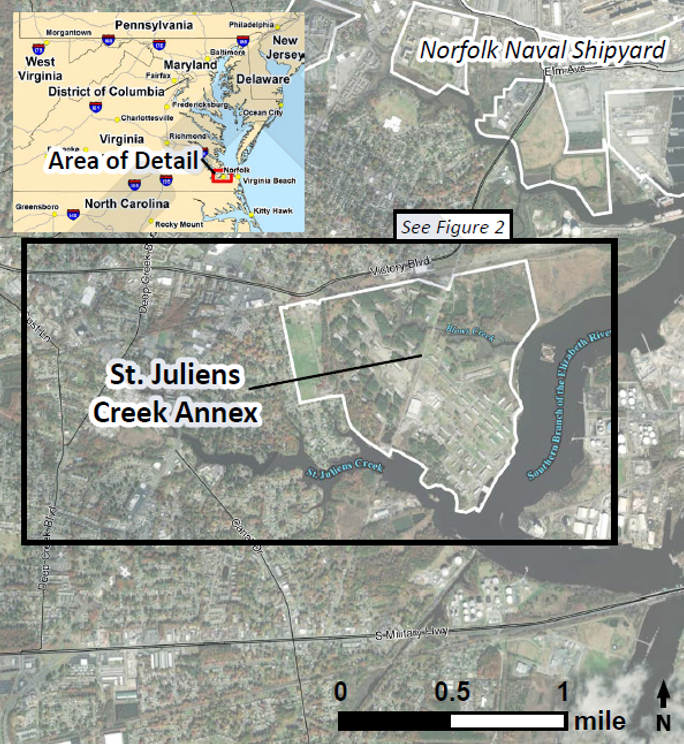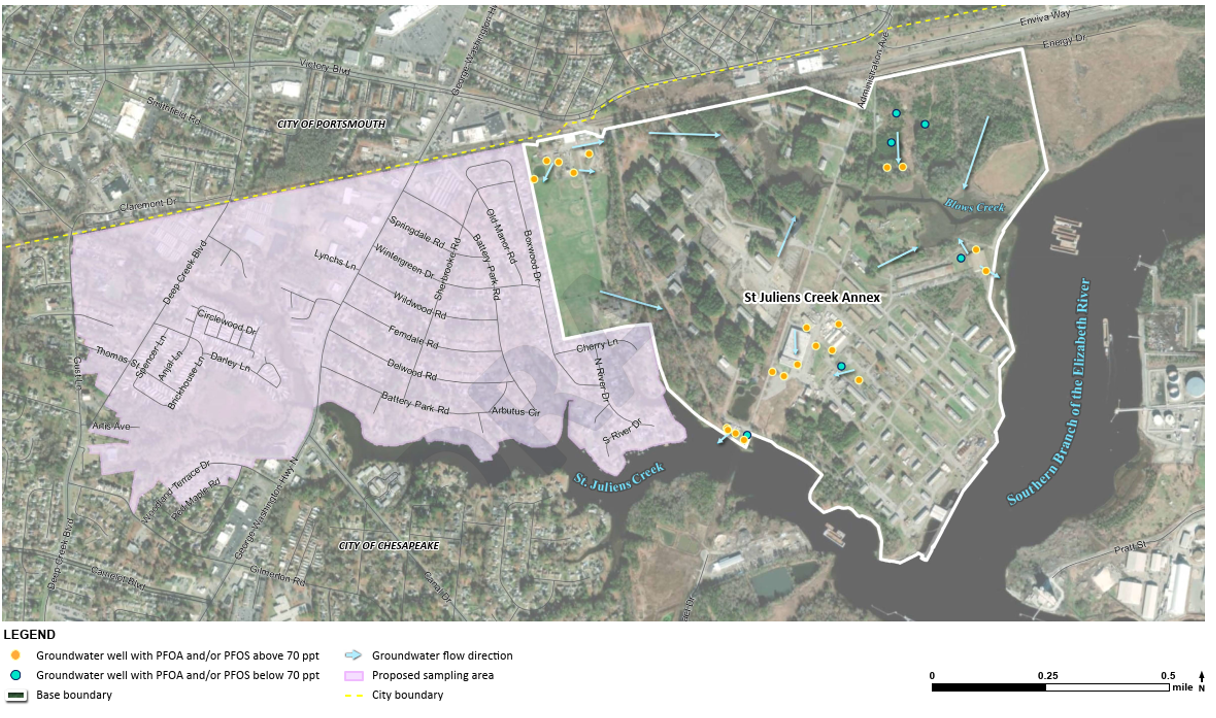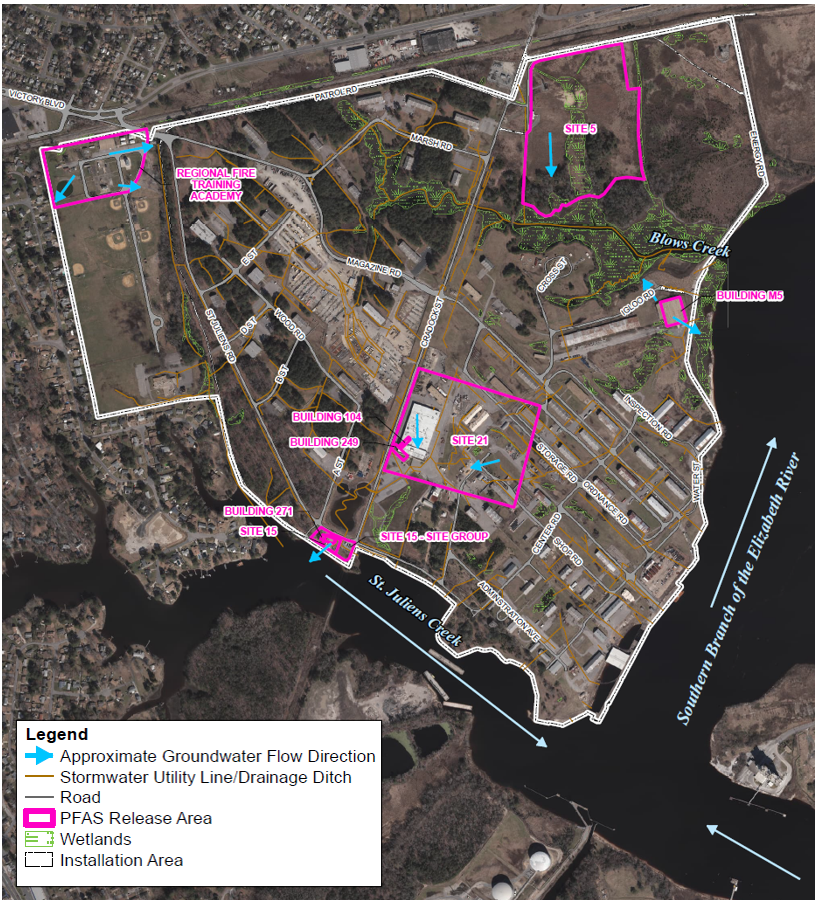|
Property owners who drink water from a well on a property located within the sampling area may request sampling by emailing NNSY_PAO@us.navy.mil or by calling 757-396-9550 to schedule a sampling appointment.
If your drinking water is provided by the City of Chesapeake Public Utilities Department and not from a well, we do not need to sample your drinking water.
|
Introduction
Per- and polyfluoroalkyl substances (PFAS) are a family of thousands of different chemicals which have been widely used in industrial and consumer products since the 1950s. PFAS are a group of manufactured chemicals that have been used in many household and industrial products because of their stain- and water-repellent properties. PFAS are now present virtually everywhere in the world. The Navy and Department of Defense (DoD) have developed proactive policies to address past releases of PFAS, including perfluorooctanoic acid (PFOA) and perfluorooctane sulfonic acid (PFOS), at installations nationwide.
The most common activity that could have resulted in the historical release of PFOA, PFOS, and other PFAS to the environment at Navy installations is the use of firefighting foam (specifically, aqueous film-forming foam, or AFFF) for testing, training, firefighting, and other life-saving emergency responses. Because of this historical use, there is potential for PFOA, PFOS, and other PFAS to be in the groundwater on-base and may be present in nearby drinking water wells that are located in the direction that the groundwater flows away from the base.
Off-Base Drinking Water Well Sampling at St. Juliens Creek Annex (Figure 1)
PFOA and PFOS have been detected in groundwater at St. Juliens Creek Annex above 70 ppt. When a known or suspected release of PFAS is identified on a Navy installation and groundwater is used as drinking water, a sampling area is established 1 mile in the direction that groundwater flows away from a release area. The Navy offers sampling to all property owners whose property is within the sampling area and whose drinking water is supplied by a well on their property.
Figure 1: Location Map of St. Juliens Creek Annex

At this time, the Navy is only asking to sample drinking water wells located in the sampling area (Figure 2). Records indicate that some properties within the sampling area (Figure 2) are provided drinking water by the City of Chesapeake Public Utilities Department. If your drinking water is provided by the City of Chesapeake Public Utilities Department, the Navy does not need to sample your drinking water. Property owners and tenants should contact the City of Chesapeake Public Utilities Department with any questions regarding treatment and testing of publicly-provided drinking water, or visit the City of Chesapeake Public Utilities Department website at: https://www.cityofchesapeake.net/water.
Figure 2: Sampling Area

Actions Based on Off-Base Drinking Water Well Sampling Results
The preliminary results from the off-base drinking water well sampling near St. Juliens Creek Annex are expected approximately 30 days after collecting the samples. The Navy provides notification to the property owners and tenants of their drinking water well results and any follow-up actions, if needed. The Navy will provide bottled water for drinking and cooking to any property in the sampling area with a drinking water well that contains PFOA and/or PFOS above 70 ppt and does not have an alternate drinking water source available. The Navy will continue to provide bottled water for drinking and cooking until a long-term solution is implemented.
2024 Off-Base Drinking Water Sampling Results
In February 2024, the Navy began sampling drinking water from private wells within the sampling area near St. Juliens Creek Annex. Table 1 summarizes the drinking water sampling results to date. Table 2 presents the PFOA, PFOS, and PFOA+PFOS results. PFOA and/or PFOS were not detected in any of the sampled drinking water wells.
Table 1. St. Juliens Creek Annex - Off-Base Drinking Water Results Summary as of July 17, 2024
| Year |
Number of Wells Sampled |
Number of wells with no detections of PFOA or PFOS |
Number of wells with detections of PFOA and/or PFOS below 70 ppt |
Number of wells with detections of PFOA and/or PFOS above 70 ppt |
| 2024 |
2 |
2 |
0 |
0 |
Table 2. St. Juliens Creek Annex – Off-Base Drinking Water Summary of Detections as of July 17, 2024
| Well |
PFOA (ppt) |
PFOS (ppt) |
PFOA+PFOS (ppt) |
| 1 |
ND |
ND |
ND |
| 2 |
ND |
ND |
ND |
Identification of PFAS Releases at St. Juliens Creek Annex
In 2021, a Preliminary Assessment (PA) for PFAS was completed at St. Juliens Creek Annex. The PA identified eight potential PFAS release areas, grouped into five areas, as shown on Figure 3. The areas are described as follows:
-
Site 5 – Burning Grounds Group (which includes the potential fire training area)
-
Site 15 – Fire Training Area Group (which includes Site 15 and Building 271)
-
Site 21 – Industrial Area Group (which includes Site 21, Building 104, and Site 9 [Building 249])
-
Building M5
-
Regional Fire Training Academy Group
The PA Report was finalized in March 2021 and can be found here: https://go.usa.gov/xSvtf.
From February 2022 to July 2022, sample collection and analysis of groundwater and soil was completed at these areas in support of the PFAS Site Inspection (SI). The Site Inspection Report was finalized in December 2023 and can be found here: https://go.usa.gov/xSvtf.
During the SI, PFOA and/or PFOS were detected in shallow groundwater above 70 ppt at each of these areas and additional information about groundwater flow was obtained. As a result, the Navy established a sampling area 1 mile from the detections of PFOA and/or PFOS above 70 ppt in the direction that groundwater flows away from the base. Based on the new information about the direction of groundwater flow, the proposed sampling area includes properties within the City of Chesapeake only and not within the City of Portsmouth. The Navy will continue on-base PFAS investigations and evaluate if actions are needed on base.
Figure 3: Areas Investigated During the PFAS SI

St. Juliens Creek Annex Drinking Water Well Sampling Documents
Additional Documents
Links